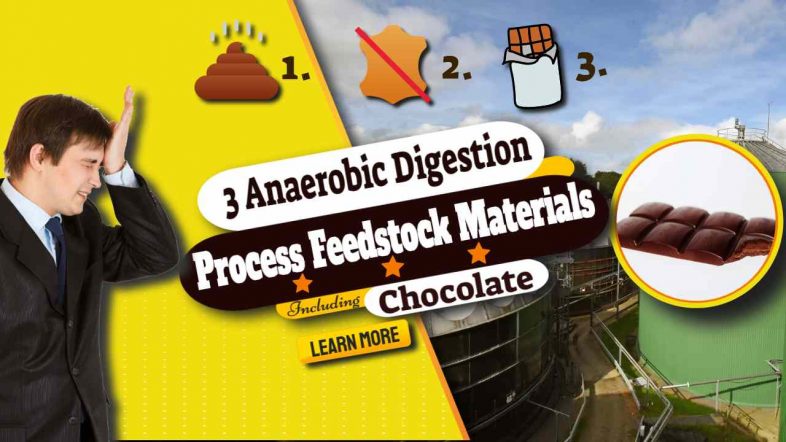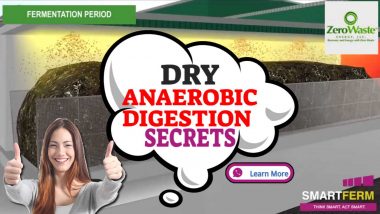Here we discuss 3 anaerobic digestion process feedstock materials, somewhat bizarrely Including Chocolate!
Many people who take an interest in Anaerobic Digestion and Biogas are fascinated by the idea that so many waste materials can be used to make green power when used as an anaerobic digestion process feedstock.
There has often been a comparatively large email “postbag” for me asking about novel organic feed materials. My usual reply is that as long as these are organic materials, they are capable of being broken down by bacteria fairly easily.
If you are new to the anaerobic digestion topic you might like to watch our video below which explains what it all means:
But, take care that your anaerobic digestion process feedstock doesn't also contain substances that may be toxic.
As long as there is no toxicity present they will usually be suitable as biogas-making digester feedstock.
Yes, including chocolate! (Scroll down to see more about that!)
I have put together today's article as a combination of some real-life cases of anaerobic digestion process feedstock materials which people have asked me whether they can use, in AD Plants, as follows:
1. Does Anaerobic Digestion Turn Dung Into Renewable Energy?
Yes, and it is one of the most common of organic materials which are used globally to feed biogas plants.
Anaerobic digestion converts cow manure (dung) into environmentally friendly energy that may be used to heat and power your home. Actually, anaerobic digestion is very often used to convert your faeces into sustainable energy as well!
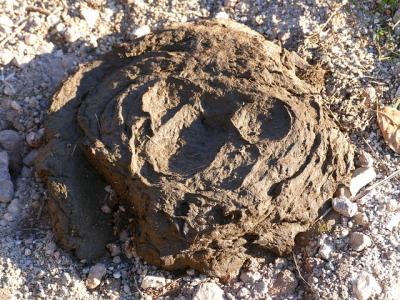
Microorganisms break down organic materials – such as farm manure – in an air-tight, oxygen-free tank in anaerobic digestion (called a digester). The hungry microorganisms eat the organic stuff and produce methane and carbon dioxide gas as they digest it. The “anaerobic digesting process” is named after this. Anaerobic digestion systems are also known as “biogas systems” since they generate gas from natural organic materials. …
Because their animal waste is collected and broken down in an airtight system, a pleasant side effect of dumping it into the anaerobic digester is a reduction in the stench of manure on the farm.
Oh, and your garbage is also used to generate green energy that is renewable. Anaerobic digesters are used in municipal water treatment plants to break down sewage sludge and eradicate pathogens in our wastewater.
Methane from our solid waste is also captured by anaerobic digesters. To avoid clogging of the pumps caused by the huge volume of organic solid waste, municipalities segregate it into different streams, such as food trash, yard waste, and soiled paper.
Each waste stream is routed into its own anaerobic digester, which breaks down the organic materials while producing biogas that may be used to generate energy and heat.
Anaerobic digestion is used in food and drink processing industries to convert waste left over from creating what we consume into renewable energy and heat, which is often enough to keep the operation running.
The anaerobic digestion process produces biogas, which can be collected and utilised to power natural gas vehicles or pumped into municipal natural gas networks to heat homes and businesses.
2. Can I Do Anaerobic Digestion of Tannery Wastes?
Traditional leather tanning produces a resulting effluent containing a considerable number of organic and chemical contaminants, making it a highly polluting process.
It is not recommended that leather tanning industry effluent is used as an anaerobic digestion process feedstock. Before allowing tannery waste to enter any AD plant we recommend that samples be analysed for contamination from heavy metals to ammonia.
Even if shown to be non-toxic we suggest that a small bench-scale pilot trial digester be set up as an experiment, and run for several months successfully, before allowing this waste into an AD plant.
The environmental impact of waste generated by the leather processing industry is significant.
According to conservative estimates, the leather industry generates more than 600,000 tonnes of solid waste every year, with shavings and trimmings accounting for 40% to 50% of the hides lost as effluent.
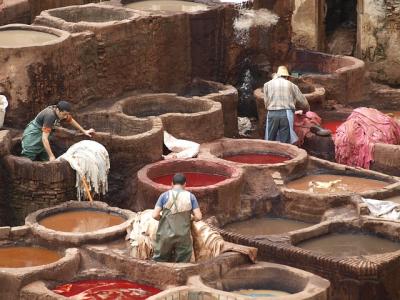
.The industries produce a large amount of waste effluent every day, including trims of completed leather, shaving dust, hair, fleshing, and trimming of raw hides and skins.
Chromium, sulphur, oils, and noxious gases (methane, ammonia, and hydrogen sulphide) are all components of the tannery industry's liquid, gaseous, and solid waste.
Biogas from Tannery Wastes
Anaerobic digestion (or “biomethanation”) systems have the potential to efficiently convert tannery wastes into energy, but tannery wastes can easily make a digester turn unproductive and sour when toxic contaminants are present in the effluent.
Take great care before using them. They can prevent biogas plant operators from achieving the goals of:
- pollution prevention/reduction,
- elimination of uncontrolled methane emissions and odour,
- recovery of bio-energy potential as biogas, and
- production of stabilised residue for use as low-grade fertiliser.
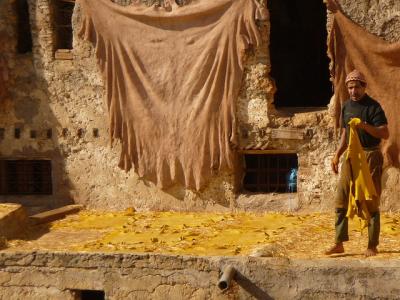
The anaerobic digestion of tannery wastes is nevertheless, a promising method for recovering energy from the waste if tannery wastes streams are kept separate.
If the feedstock material used is free from all metals such as chromium and other chemicals toxic to methanogens such as very high ammonia concentration effluent this organic material can be used.
This AD approach destroys a significant portion of the organic matter in sludge and tannery solid wastes, creating valuable biogas. This creates income to pay for more sustainable treatment and disposal methods of the much smaller quantity of remaining toxic chemical waste.
Furthermore, after going through the anaerobic digestion process, digested solid waste is biologically stabilised and can be used in agriculture.
Until now, it was thought that the complexity of tannery effluent, along with the presence of chroming, would result in the process being poisoned in a high-loaded anaerobic reactor. But, this has now been proved to be incorrect, when sufficient care is taken.
In fact, it may be possible for clean non-toxic tannery waste to be co-digested at anaerobic digestion plants which are also used for the treatment of sewage sludge at a local public sewage treatment works (WWTW).
If a sewage sludge facility at a WWTW is not accessible at the local industrial wastewater treatment plant, large-scale digestion can be developed in locations with a significant cluster of tanneries if there is enough waste to make the facility economically viable.
In this case, an anaerobic co-digestion plant based on sludge and tanneries, which decreases the amount of landfilled waste while recovering its energy potential, may be a viable solution.
It can also include any other kind of trash from the home, industry, or agriculture.
Because of its nutritious content, chrome-free digested tannery sludge has obvious use as a fertiliser.
An Exception to the Rule! The AD Plant at ECCO’s Tannery (Netherlands)
In 2012, ECCO's tannery in the Netherlands completed the installation of a cutting-edge wastewater treatment plant and biogas system.
A major portion of the local garbage is pumped straight into the wastewater treatment plant, where it is transformed into biogas.
By also converting the non-toxic waste from both the leather-making processes and the wastewater treatment plant into biogas utilising the anaerobic digestion process, this biogas digester provides a renewable fuel source. Simultaneously, it is also assisting in the disposal of organic household waste materials.
All of the organic waste from the hides is transformed into biogas as well.
This project allows ECCO Tannery to cut waste and replace nearly all of its non-renewable natural gas use with renewable biogas.
The goal is to use biogas to replace up to 60% of total natural gas usage and use more than 40% of total tannery waste. via Anaerobic Digestion of Tannery Wastes
3. Anaerobic digestion process turns chocolate into renewable energy
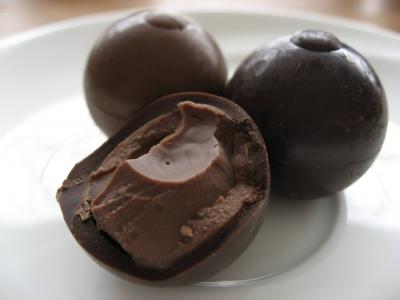
A Nestlé facility uses anaerobic digestion to convert waste chocolate into renewable electricity.
Nestlé's facility in Fawdon has installed an anaerobic digestion system that converts chocolate and sugar confectionery waste into sustainable energy and clean water.
Rejected chocolates and candies that aren't fit for sale or reprocessing are broken down into small bits, as are waste leftovers like starch and sugar.
To make a ‘chocolate soup,' the combination is partially dissolved using waste liquids from the site's cleaning procedures. The resulting “chocolate soup” is then placed into an airtight tank, where anaerobic digestion takes place.
The natural process of microbes breaking down biodegradable material, such as food, without oxygen and transforming it into beneficial by-products is known as anaerobic digestion. These by-products help to meet a portion of the site's energy requirements.
While the technology has been used in agriculture and industry for millennia, the Fawdon system is unique in that it was built to handle a large volume of solid and liquid waste in a short amount of time.
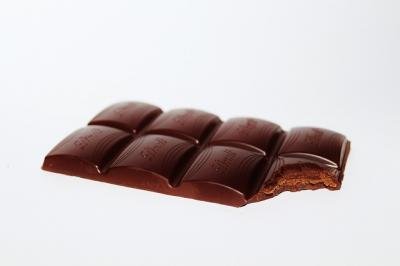
“The system allows us to add tougher residues like starch-based compounds to the process, along with reject product and other materials,”
says Inder Poonaji, Nestlé UK and Ireland’s Head of Sustainability.
“As long as the material is biodegradable, the anaerobic conversion process can take place. The waste we are converting here would otherwise be disposed of externally.”
via Anaerobic digestion turns chocolate into renewable energy
Biogas created during anaerobic digestion now provides 10% of Fawdon’s energy
Biogas is a renewable gas made primarily of methane and carbon dioxide that is produced as a by-product of anaerobic digestion.
Fawdon's biogas is burned to provide enough heat and power to cover around 10% of the site's overall energy requirements. Fawdon's greenhouse gas emissions are predicted to drop by roughly 10% as a result of the biogas-generated heat and power.
The anaerobic digester has improved the quality of water discharged from the factory, which is equivalent to 41 Olympic-size swimming pools yearly, in addition to creating cleaner energy.
Although the factory is now experiencing the rewards of the project, doing it correctly takes money and time.
The concept was trialled for three months at the site, with a smaller version of the anaerobic digester.
“There were a lot of things to think about,” Inder explains. “Determining which microorganisms to utilise necessitated extensive research and testing. Before moving forward, we had to start small.”
Fawdon's anaerobic digestion system cost roughly £3.3 million to install. The cost of such systems has sometimes been a stumbling block to the wider adoption of similar techniques. The investment, however, is expected to pay off in four years due to the cost savings it has achieved.
The Fawdon's anaerobic digestion processing is now carried out in a massive tank brimming with naturally occurring microorganisms. It transforms around four tonnes of solid trash and 200,000 litres of liquid waste every day, making it one of Nestlé's 72 facilities worldwide with zero waste for disposal.
Nestlé set a goal of having zero waste for disposal in 10% of its operations by 2015, which it met two years early in 2013, with 56 of its factories, or 11%, meeting the goal.
Concluding – 3 Examples of Anaerobic Digestion Process Feedstock
Well, who would have thought that there was such a thing as “rejected chocolate“!
All I can say is that any chocolate that ever enters our house gets eaten (and quickly too!) so, the concept of chocolate waste is a new one for me (and I guess for most people)!
However, it would be sad if it was being wasted, so making renewable energy from it, by using it as an anaerobic digestion process feedstock, must surely be a very good idea.
[Article originally published in December 2015. Latest update July 2021]
